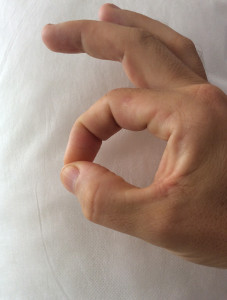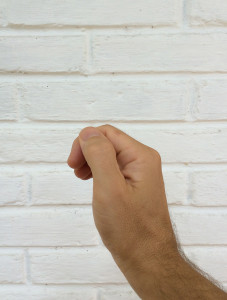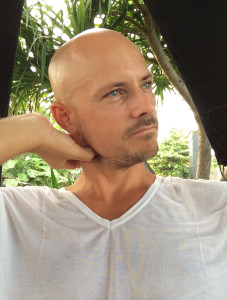Massaging SCM (Sterno)
Sternocleidomastoid (or just called SCM) is the most important muscle when it comes to any kind of symptom in the head. It is made up of two rolls of muscle about the thickness of a finger each and isattached to bone 3 places: On the collarbone, on the sternum and on the mastoid process right behind the ear.
Try squeezing the SCM muscle. Is it sore? Is pain radiating upwards to the head and face if you press it hard? This is all the proof you need to realize that some of your symptoms come from trigger points in this muscle and it needs to be massaged until the trigger points disappear - there can be NO tender/sore spots left in the Sterno!
On this illustration you can see how trigger points in Sterno (marked with crosses) radiate pain upwards to the head and the face (marked with red).
How to find the SCM
Having trouble finding the SCM? Watch the video.
CUT YOUR NAILS! If you cannot grab it, it might be because your nails are long. They need to be cut down ALL THE WAY so they don't get in the way of a good solid grip.
Massage the SCM 2-3 hours per day.
As long as you have your hands free you can massage the SCM. Massage it when you are walking, when you are waiting in line, when you are on the bus, when you are waiting for your coffee to brew, when you are on your phone, even when you are working at the computer. Your hands are actually free most of the time. Use that time to massage and you will quickly get to 2-3 hours per day.
Make it a habit.
The biggest challenge is to actually remember to massage as you go about your daily life. So, how do you actually remember to do it? The answer is that you have to turn it into a habit. A habit is something you do without thinking about it. You just do it automatically. The next question then is, how do you turn it into a habit?
The answer is to go through a 7 day "SCM challenge":
- Pick 4 activities that you can do while massaging. Examples could be: walking, driving, sitting at your computer, looking at your phone, etc.
- Perform each of those activities for 10 minutes WHILE massaging your scm. That would be 40 minutes per day. For example, you might go for a 10 minute walk in the morning while massaging your scm. Then go drive in your car for 10 minutes in the afternoon while massaging your scm, and so on.
- Do this every day for 7 days and you should be on your way to make the scm massage a habit.
- Draw a table on a piece of paper with 4 rows (one for each activity) and 7 columns (one for each day) and put a check mark every time you have performed an activity while massaging.
Symptoms
Trigger points in Sterno are responsible for a strange collection of symptoms in the head. From headache and tooth aches to problems with your balance and hearing.
Pain in the teeth
Pain in the jaw
Pain in the temples
Pain in the back of the head
Pain on the top of the head
Pain in the forehead
Sensitivity to light
Sensitivity to sounds
Problems focussing on text
Watery eyes
A running nose
Hay fewer symptoms
Nausea
Vertigo / Problems with the balance
Irritation of the eyes
A sensation of living in jelly / in a dream
The Massage
Optimally, Sterno needs to be massaged at least 8 times a day evenly distributed throughout the day but if you are following the Basic Head Program it will be treated 4 times a day. But it will benefit you greatly if you can massage the Sterno all throughout the day between the actual massage sessions. You could easily massage it 10-20 times a day. Massage it when your waiting for the bus, watching TV, in the queue in the supermarket, drinking coffee with a friend. Basically any time your hands are not occupied with other tasks they should be massaging Sterno.
Use the grips described below to find and treat any sore trigger points in Sterno. The more it hurt and radiate out the ”better” the trigger point. When you’ve found a good trigger point you must keep a pressure for ½ to 1 minute on each of them.
It is not important how hard you press but only how much it hurts when you press. Imagine a pain scale of 1-10 where 1 is no pain and 10 is unbearable pain, then you should go for a 5 – you need to be able to feel it but the pain should feel good. Some people need to apply a lot of pressure to get to a 5 and some people barely need to touch it.
When you are just starting out however you should watch out and only start the massage at a 2. Many people just starting out wrongfully think that the harder they press the better. But that is entirely wrong. Many start out pressing so hard that their symptoms increase dramatically immediately after the massage and they end up having to spend several days in bed.
WARNING! To many people quit the program because their Sterno is ”to” sore or because they press to hard. This is nothing less than a personal tragedy as they are quitting the path to recovery before they even really get started. If your Sterno is ”to” sore this is EXACTLY the reason to continue the program – not to stop! So if you find yourself trying to bare the pain while pressing, grinding your teeth in pain trying to stand it then you are applying far to much pressure.
Massage Grips
For some people, using many different hand grips when massaging Sterno comes very natural – they don’t think about how to position their hands when applying pressure to Sterno. For others, massaging Sterno just feels very awkward. Below you can see a selection of those basic hand grips I use when instructing in Sterno massage. Each of them can do something different and you should try to master all of them. It is also good to be able to switch if your hands are getting tired. If you find it difficult in the beginning, don’t quit – after a bit of practice each of them will feel natural to you. You will also gain more strength in your hands.
A - Finger Tip Grip:
In this grip you press the finger tips together. It is not the finger surfaces that are pressed together as this requires a lot more strength which makes it harder to maintain the pressure. If however you choose to press the finger surfaces together instead of the finger tips you should expect to tire more quickly.
A1) With the index finger
A2) With the middle finger
A3) With the both the index and middle finger
B - Supported thumb pressure
In this grip, the thumb presses down on the other 4 fingers which lie below each other to support the pressure from the thumb. You can press down on the index finger at different places.
B1) Pressing on the first part of the index finger
B2) Pressing on the second part of the index finger
C - Finger pull
Here the thump is passive and all the power comes from the index finger and middle finger.
D - Straight Thumb Pressure:
The idea with this hand position is to push the thumb directly into Sterno using the neck itself as support for the pressure. The other 4 fingers are passive and can therefore relax. You can press with the tip of your thumb or the palm of your thumb but if you want to use the least amount of power you need to position your thumb as an extension of your arm so that you are pressing with the tip of the thumb. I can also recommend supporting your elbow on a table or with cushions. This method only works on the top very top of Sterno where the muscle is less loose.
E - Finger surface pressure:
Here you are pressing together the finger surfaces instead of the finger tips, but to deliver more pleasure the middle finger lies on top of the index finger.
















